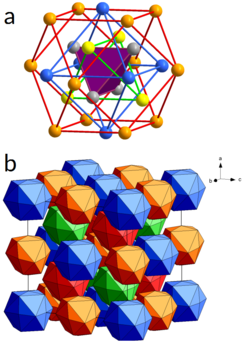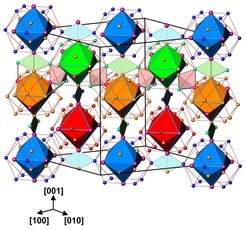Be21Pt5: a superconducting complex electron-poor intermetallic phase
Complex intermetallic compounds fascinate crystallographers with their extended unit cells containing from several hundred up to several thousand atoms and the implications for their electronic structure. Recently, the crystal structure of the superconductor Be21Pt5 could be resolved by a combination of synchrotron and neutron powder diffraction, in a joint effort of scientists from the Max-Planck Institute for Chemical Physics of Solids, the Australian Nuclear Science and Technology Organisation (ANSTO), the Helmholtz-Zentrum Dresden-Rossendorf, the Technical University Freiberg and the Ivan-Franko National University Lviv.
Be21Pt5 is a complex γ-brass superstructure of the simple bcc pattern, with a distinct distribution of defects, which can be described by means of nested-polyhedral units. These 26-atom clusters consist of four concentrically arranged polyhedral shells (Fig. 1). The observed large translational periodicity is a consequence of the distinct ordering of the Pt atoms, enforced by the large size difference and strong charge transfer from Be to Pt.
Real space analysis of the calculated electron density and the electron localizability indicator (ELI) shed light on the chemical bonding scenario in this intricate structure. For the first time the concerted participation of up to 14 atoms in a bonding interaction was observed, and consequently termed cluster bond. These collectivized interactions are a consequence of the strong valence electron demand in this compound. This description gives first evidence of localized interactions in large-unit cell complex intermetallic compounds, which are often explained in the Hume-Rothery band structure picture. Be21Pt5 displays structural units with collective intra-cluster bonding which are linked in the structure by strongly polar three-center interactions (Fig. 2).
Extraordinarily, Be21Pt5 is a rare case of superconductivity in a complex intermetallic compound (Tc = 2 K), which is usually inhibited by pseudo-gap formation at the Fermi-level.
AA ; YG / CPfS

Figure 1. Atomic arrangement in the 26-atom nested polyhedral unit in Be21Pt5 (a) and arrangement of the clusters in the unit cell (b).

Figure 2. Atomic interactions in Be21Pt5. The regions with strongly collectivized cluster bonding are shown in form of the closed octahedra with the cuboctahedra shells wired around. Linking three-center bonding Pt-Be-Be interactions between the cluster regions are shown by triangles.

